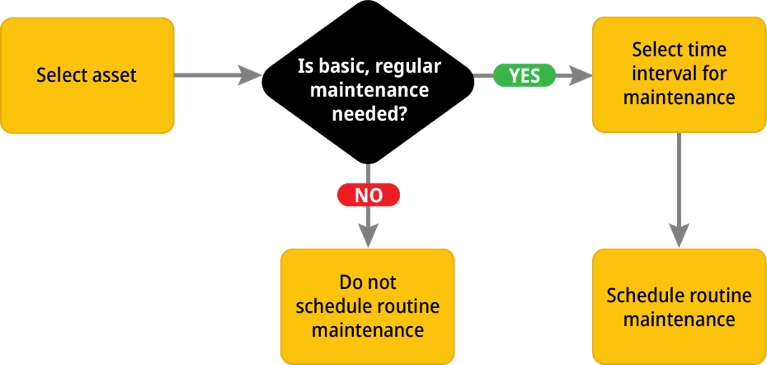
What Is Routine Maintenance?
Routine maintenance involves performing regular, scheduled tasks to ensure the optimal functioning and longevity of equipment and facilities. These tasks, done at consistent intervals, help identify and address potential issues before they lead to costly failures. Examples of routine maintenance include inspecting and servicing machinery, replenishing supplies in restrooms, and conducting safety checks. By adhering to a routine maintenance schedule, businesses can enhance efficiency, reduce downtime, and extend the lifespan of their assets.

Routine maintenance refers to maintenance tasks that are carried out on a regular basis to prevent equipment failure. Cleaning, lubricating, and changing parts are all good examples of routine maintenance. So are regular machine inspections.
Most of the time, routine maintenance jobs are calendar-based. For example, certain parts might need to be replaced every six months. But some routine maintenance tasks are usage-based, like changing a car’s oil after driving 3,000 miles.
Done right, routine maintenance can prevent or catch potential problems early on, while they are still easy to fix. Most routine maintenance tasks are simple enough for machine operators to do on their own, which leaves your technicians free to focus on more complex work.
Examples of Routine Maintenance
Examples of routine maintenance tasks include:
- Lubricating, cleaning, or adjusting machinery
- Inspecting equipment for proper operation and safety
- Replacing worn or deteriorating parts
- Checking and maintaining safety equipment like fire extinguishers and alarm systems
- Replacing damaged signage or utilities, such as light bulbs
- General workplace maintenance, including cleaning floors, replacing HVAC filters, washing windows, trash removal, and landscaping
By regularly performing these tasks, you can ensure equipment longevity and a safe working environment.
What Are the Benefits of Routine Maintenance
Routine maintenance is a vital part of any preventive maintenance strategy. It can save your operation from the expense, stress, and unplanned downtime that typically comes with a reactive maintenance approach.
The most significant benefit of routine maintenance is increased reliability. Routine maintenance ensures that your assets stay up and running for longer. And when there’s a problem, routine inspections catch it early so you aren’t blindsided in the middle of your busy production cycle.
Routine maintenance has other baked-in benefits, too. Staying on top of routine maintenance can:
Reduce the cost of maintenance
It’s like the old saying – a stitch in time saves nine. By performing minor maintenance tasks on a regular basis, you can help prevent asset breakdowns. That means you won’t need to call in your technicians for extensive, costly repairs.
Increase productivity
Machines that are regularly serviced perform better. By regularly changing parts, lubricating, and cleaning components, you’ll ensure that your assets stay in top condition. You won’t have to deal with unexpected breakdowns. You also won’t face slowdowns or reductions in product quality.
Help with inventory planning and scheduling
Sticking to a maintenance routine means you know what to expect. This makes inventory and scheduling much easier.
How Does Routine Maintenance Decrease Downtime?
Routine maintenance can dramatically decrease unplanned downtime. By regularly servicing machinery, teams can prevent sudden breakdowns. Routine maintenance also protects against slowdowns by keeping equipment in top running condition.
Routine Maintenance Identifies Problems Early
Inspecting machinery is an important part of routine maintenance. Depending on the machinery, maintenance workers will test its condition monthly, quarterly, or annually. This ensures your team will spot the first signs of a new machine fault.
Conducting such routine maintenance gives technicians plenty of time to repair a fault before they are forced to take the asset offline.
Routine Maintenance Keeps Machines in Top Working Order
Over time, excess wear and tear can cause severe machine defects. Routine maintenance helps prevent this.
Proper lubrication protects assets from friction and overheating. And performing checks and adjustments can fix imbalance issues. Regular cleaning, replacing deteriorating parts, and changing filters also help keep your critical assets up and running longer.
How to Maximize Routine Maintenance
There are a few key factors that can take routine maintenance to the next level:
Optimizing scheduling for each asset. It’s important to figure out exactly how often each machine needs adjusting, cleaning, and lubrication. It’s also important to figure out exactly how often each part needs to be changed.
Assigning responsibility. Maintenance works best when one team member is in charge of each task. Otherwise, there’s a risk that jobs will slip through the cracks.
Putting quality checks in place. Set up the means to check whether tasks are being completed correctly.
Getting the timing right. Where possible, schedule routine maintenance tasks for times when your machines are already offline. If you need to schedule repairs, find a time when your technicians are already on location.
How eMaint CMMS Supports Routine Maintenance
eMaint CMMS provides the tools, the structure, and the insights to take routine maintenance to the next level.
eMaint’s robust reporting capabilities give you valuable insights into each asset’s needs. For example, it’s easy to run a query on how often each asset needs lubrication, shaft adjustment, or a new belt. You can then use those insights to build and schedule the optimal routine maintenance plan.
eMaint can also greatly help with scheduling. The software tracks your existing maintenance jobs and available team members. eMaint can even assign jobs to specific people based on their skills and expertise. Best of all, eMaint can automatically generate work orders, and managers can build in checklists and benchmarks to ensure that every job gets done right.
The result? Increased uptime and lower costs – it’s a win-win!

